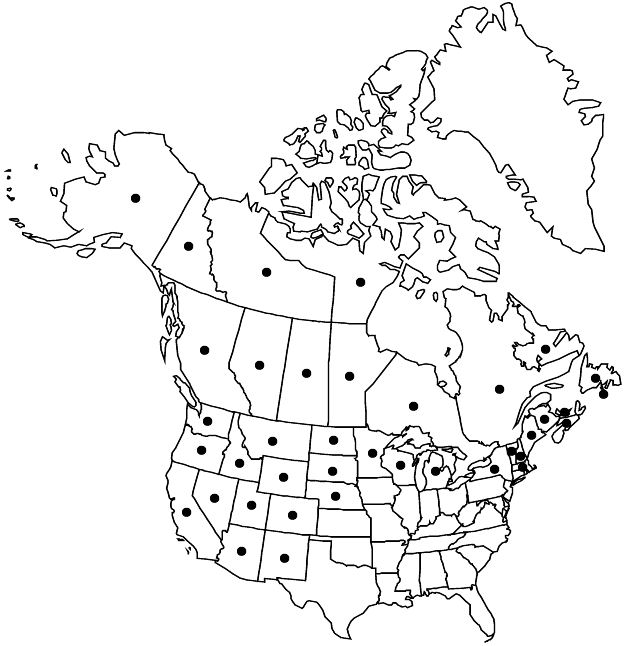Geum macrophyllum
Enum. Pl., 557. 1809.
Plants leafy-stemmed. Stems 30–110 cm, puberulent and hirsute or sparsely hirsute. Leaves: basal 10–45 cm, blade interruptedly lyrate-pinnate, major leaflets 5–9, alternating with 4–15 minor ones, terminal leaflet usually much larger than major laterals; cauline 2–12 cm, stipules ± free, 7–23 × 3–12 mm, blade lyrate-pinnate, pinnate, 3-foliolate, or simple and 3-lobed. Inflorescences 3–16-flowered. Pedicels densely puberulent, sometimes with scattered longer hairs, sometimes stipitate-glandular. Flowers erect; epicalyx bractlets often absent, 0.5–2 mm; hypanthium green; sepals erect-spreading but soon reflexed, 2.5–5.5 mm; petals spreading, yellow, obovate, broadly elliptic, or suborbiculate, 3.5–7 mm, longer than sepals, apex rounded. Fruiting tori sessile or on less than 1 mm stipes, puberulent. Fruiting styles geniculate-jointed, proximal segment persistent, 2.5–6 mm, apex hooked, sparsely to densely stipitate-glandular, distal segment deciduous, 1–2 mm, pilose in basal 1/3, hairs much longer than diam. of style.
Distribution

Alta., B.C., Man., N.B., N.S., N.W.T., Nunavut, Ont., P.E.I., Que., Sask., Yukon, Alaska, Ariz., Calif., Colo., Idaho, Maine, Mass., Mich., Minn., Mont., N.Dak., N.H., N.Mex., N.Y., Nebr., Nev., Oreg., S.Dak., Utah, Vt., Wash., Wis., Wyo., Eurasia
Discussion
Varieties 2 (2 in the flora).
Characters useful in recognizing specimens of Geum macrophyllum are yellow petals, epicalyx bractlets often absent, proximal style segment sparsely to densely stipitate-glandular, and fruiting receptacles puberulent. Across its broad North American range from Alaska to California and Nova Scotia, G. macrophyllum exhibits considerable variation. Based largely on the shape of the terminal leaflet of the basal leaves and the degree of dissection and shape of the divisions of the distal cauline leaves, P. A. Rydberg (1913b) distinguished three species within the range of variation treated here as one species. Basal leaves of G. macrophyllum in the strict sense (var. macrophyllum in this treatment) have relatively large reniform to rounded terminal leaflets and the distal cauline leaves are three-cleft into rhombic or cuneate lobes. The basal-leaf terminal leaflets of G. perincisum (= var. perincisum) are only slightly larger than the laterals and are deeply lobed into rhombic-obovate segments; the distal cauline leaves are dissected into oblanceolate divisions. Both basal and cauline leaves of G. oregonense (= var. perincisum) are intermediate between those of G. macrophyllum and G. perincisum. W. Gajewski (1955) crossed all three taxa under discussion and examined leaf morphology and cytology of the F1 and F2 hybrids. He concluded that they were distinct but not yet completely separated species. Fairly well correlated with the more dissected leaves of G. oregonense and G. perincisum is the presence of minute stalked glands on the pedicels. The treatment here follows H. M. Raup (1931) in recognizing two varieties of G. macrophyllum based more on pedicel glandularity than leaf morphology.
Selected References
None.
Key
| 1 | Pedicels not glandular-puberulent; cauline leaves with distal simple and 3-lobed (divided less than 3/4 to base), lobes rhombic-oblong. | Geum macrophyllum var. macrophyllum |
| 1 | Pedicels glandular-puberulent; cauline leaves with distal 3-foliolate or simple and 3-lobed (divided almost to base), lobes oblanceolate to obovate. | Geum macrophyllum var. perincisum |
"thin" is not a number."elongating" is not a number. "elongating" is not a number.